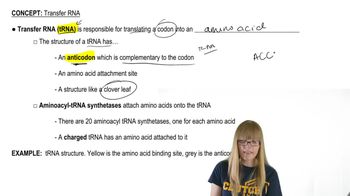What are isoaccepting tRNAs? Assuming that there are only 20 different aminoacyl tRNA synthetases but 31 different tRNAs, speculate on parameters that might be used to ensure that each charged tRNA has received the correct amino acid.
Table of contents
- 1. Introduction to Genetics51m
- 2. Mendel's Laws of Inheritance3h 37m
- 3. Extensions to Mendelian Inheritance2h 41m
- 4. Genetic Mapping and Linkage2h 28m
- 5. Genetics of Bacteria and Viruses1h 21m
- 6. Chromosomal Variation1h 48m
- 7. DNA and Chromosome Structure56m
- 8. DNA Replication1h 10m
- 9. Mitosis and Meiosis1h 34m
- 10. Transcription1h 0m
- 11. Translation58m
- 12. Gene Regulation in Prokaryotes1h 19m
- 13. Gene Regulation in Eukaryotes44m
- 14. Genetic Control of Development44m
- 15. Genomes and Genomics1h 50m
- 16. Transposable Elements47m
- 17. Mutation, Repair, and Recombination1h 6m
- 18. Molecular Genetic Tools19m
- 19. Cancer Genetics29m
- 20. Quantitative Genetics1h 26m
- 21. Population Genetics50m
- 22. Evolutionary Genetics29m
11. Translation
Transfer RNA
Problem 20b
Textbook Question
Describe the roles and relationships between tRNA anticodon sequences and mRNA codon sequences.
 Verified step by step guidance
Verified step by step guidance1
Understand the structure of mRNA codons: mRNA is composed of nucleotide sequences organized into codons, which are groups of three nucleotides. Each codon corresponds to a specific amino acid or a stop signal during translation.
Learn the structure of tRNA: Transfer RNA (tRNA) molecules have an anticodon region that consists of three nucleotides complementary to the mRNA codon. This allows tRNA to recognize and bind to the correct codon on the mRNA strand.
Explore the base-pairing rules: The anticodon on tRNA pairs with the mRNA codon through complementary base pairing. For example, adenine (A) pairs with uracil (U), and cytosine (C) pairs with guanine (G). This ensures accurate translation of the genetic code.
Understand the role of tRNA in translation: tRNA carries specific amino acids to the ribosome. When the anticodon of tRNA binds to the corresponding mRNA codon, the ribosome facilitates the addition of the amino acid to the growing polypeptide chain.
Recognize the importance of codon-anticodon interaction: The precise pairing between mRNA codons and tRNA anticodons ensures that the correct sequence of amino acids is assembled, which is critical for producing functional proteins.
 Verified video answer for a similar problem:
Verified video answer for a similar problem:This video solution was recommended by our tutors as helpful for the problem above
Video duration:
3mPlay a video:
Was this helpful?
Key Concepts
Here are the essential concepts you must grasp in order to answer the question correctly.
tRNA and Anticodons
Transfer RNA (tRNA) is a type of RNA molecule that helps decode mRNA sequences into proteins. Each tRNA molecule has a specific three-nucleotide sequence called an anticodon, which is complementary to a corresponding codon on the mRNA. This complementary pairing ensures that the correct amino acid is added to the growing polypeptide chain during protein synthesis.
Recommended video:
mRNA and Codons
Messenger RNA (mRNA) is a single-stranded RNA that carries genetic information from DNA to the ribosome, where proteins are synthesized. The mRNA is read in sets of three nucleotides known as codons, each of which specifies a particular amino acid. The sequence of codons in mRNA determines the order of amino acids in a protein, which is crucial for its function.
Recommended video:
Guided course

mRNA Processing
Translation Process
Translation is the process by which the genetic code carried by mRNA is translated into a sequence of amino acids to form a protein. During translation, ribosomes facilitate the binding of tRNA anticodons to mRNA codons, ensuring that the correct amino acids are linked together in the proper order. This process is essential for gene expression and the synthesis of functional proteins.
Recommended video:
Guided course

mRNA Processing
Related Videos
Related Practice
Textbook Question
1101
views



